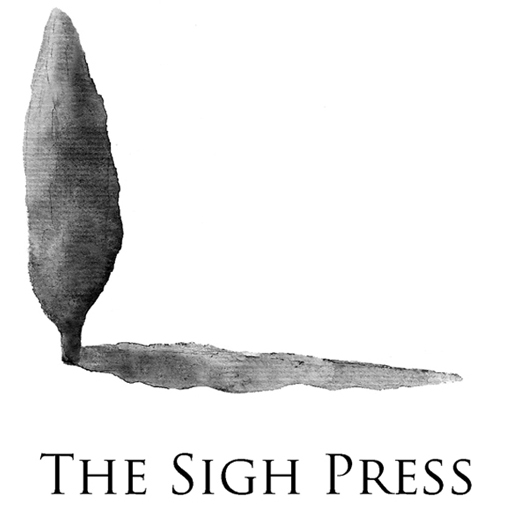
Notes from The Sigh Press Editors
Mundy Walsh & Lyall Harris
This issue’s theme is “Last Stop First Stop.” Lately, it seems like they are one in the same. (And, besides, every day we wake up is a first stop.)
We are thrilled to publish new work by accomplished and award- winning poet Alex Josephy who kept the issue theme in mind as she developed these poems. Insightful, often humorous creative nonfiction recounting his US book tour from Baret Magarian documents many stops along an interior and exterior landscape. Photos from Baret’s voyage seemed fitting for the issue as well, and his essay, “My American Odyssey,” more than qualifies for our Cultural Commentary section.
If you haven’t yet read our recent interview with Alex Josephy in our Ampersand 13, we hope you will! She offers many insightful nuggets as she shares aspects of her creative practice and reflections on bridging places and identities.
Please visit thesighpress.com for our next issue theme and submission deadline. We post regularly on our Facebook page.
Read about the contributors to this issue and see the PDF version of this issue at The Journal.
Subscribe to our newsletter, where you’ll receive the latest issues, Ampersand interviews and news:
Contents
*
,
[ ] ´
?
*
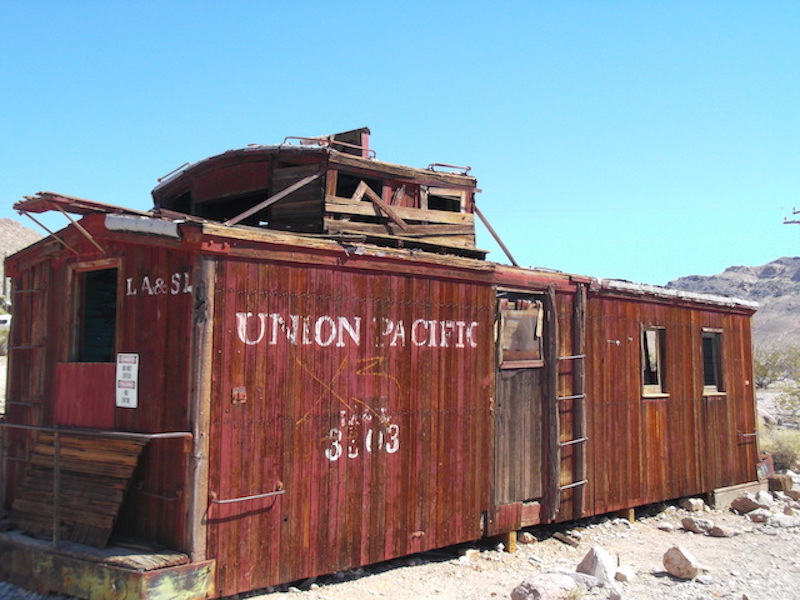
UNION PACIFIC
,
7.2.51
Alex Josephy
Febbraio, febbraietto
Corto, corto, e maledetto.
February, little February,
Short, short
And accursed!
No-one would claim it; I revolve
around it, axis of my life, black hole
at the centre of my LP. Odd,
even, odd again, birth numbers
stand in every record, every file
on me, point toward northern stars
my odd mind chooses to follow.
Tilted rays of February,
clear through frost, I watch you
keep your distance, count it
in light-years. Short, sharp
febbraio, you’re what I know.
Hold your invernal brood; keep us
cussed, truthful, close to winter.
NOT YET
The 9.05
slides out of London Bridge
on icy bends.
Slant light lifts from the trees
all silver-birched,
derelict nests.
Woman and dog
perform long division
across the powder common
goalpost to goalpost to fence.
White shadow
beneath a spinney.
Catkin curtain,
silky-netted clematis
soft-furnishes a hedge
and then the allotments.
Ache-sharp cabbage stalks.
A diamond shed.
LONDON BLUE
The boy on a cardboard raft
beside the revolving doors
of Selfridges, its bay
of warm conditioned air,
is setting out with only a small dog
for company, across the ocean
that begins in Oxford Street,
that might go on
to the edge of the world.
LA FLIGHT
You’re at Gatwick, I’m in the kitchen
brewing tea. This mug’s as hard
and hollow and strange as an aircraft
engine part. The teaspoon chimes
on china: proceed to check-out,
to the Departures Lounge,
the gate. My teabag swells into
an inflatable slide. You’re ready
to board. The sea-stone I keep
by the caddy, with its white markings,
its memories of summer beach,
turns in my hand, a charm, a pilot’s chart.
LAGOON DREAMS
Do dreams in Venice have more potency
than mainland dreams? Here, nightmares squat
gleefully over trembling sinners, scorn
the petty tooth-grinding, mastication
of boring land-locked days. Here, our mattress
hovers over water, the house doors open
onto water, eyes are water-skins. Close them,
sense small ripples that strum the bed’s
frail under-ribs, sing gibaghabba
up and down the wall. We turn toward each other,
sleep-caress. Between our dissolution
and the sea, only a shake of salt, a water-gate.
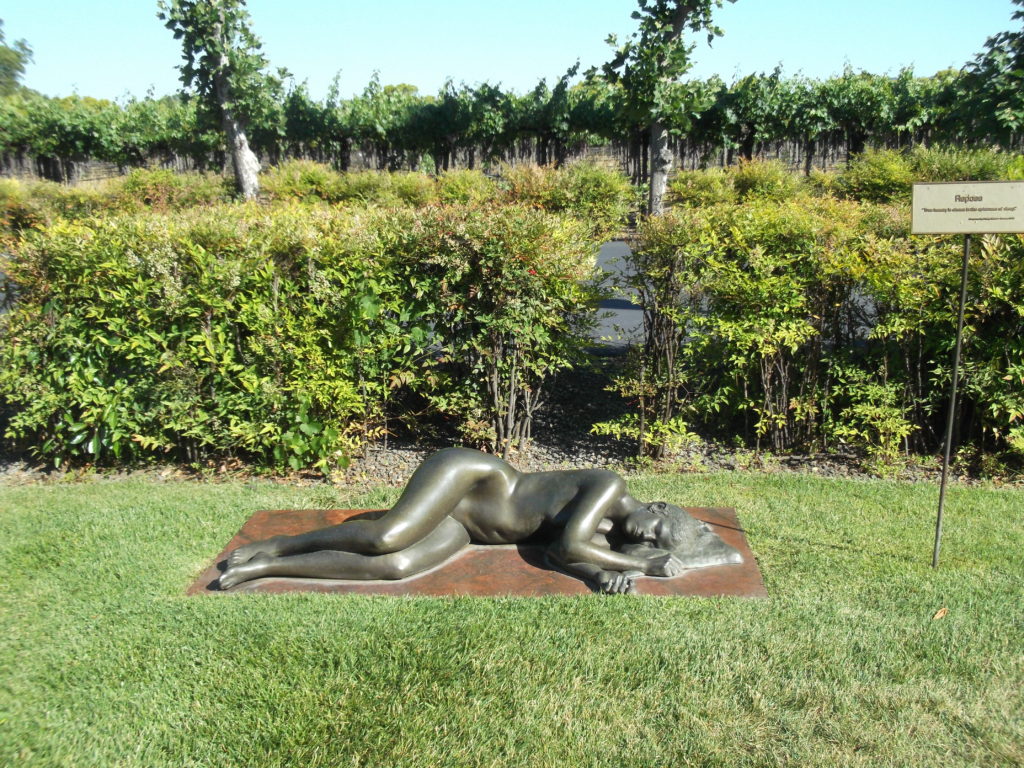
NAPA VALLEY
[] ´
MY AMERICAN ODYSSEY
BARET MAGARIAN
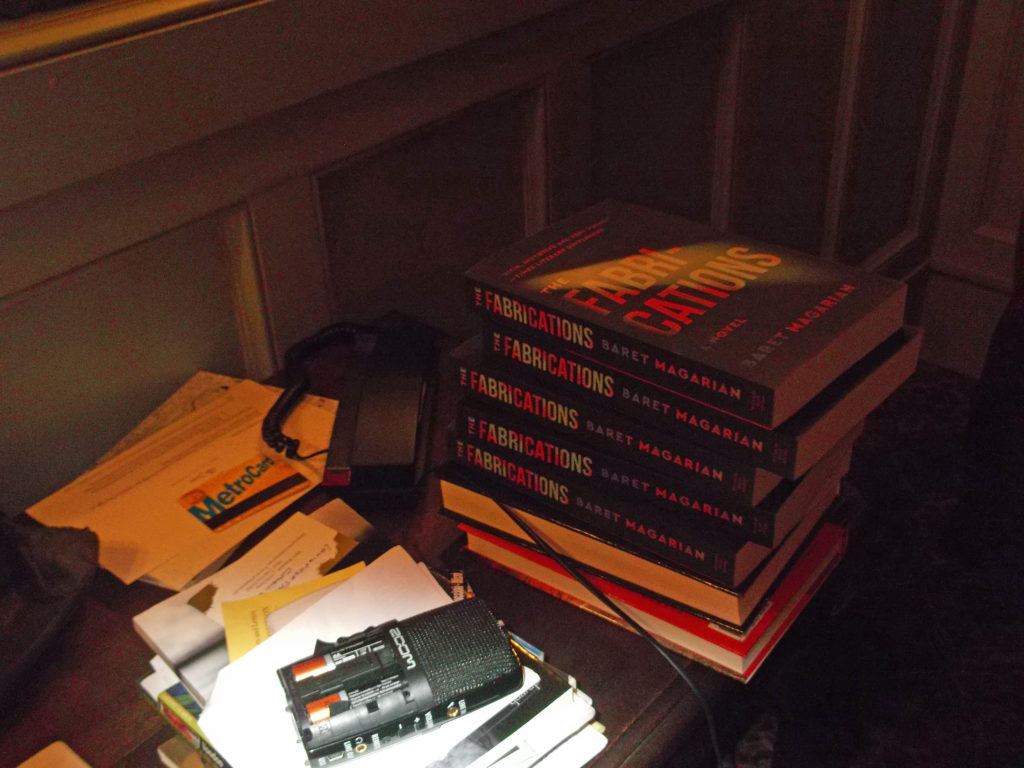
MY HOTEL ROOM, NEW YORK
Last year I saw the movie The End of the Tour, which is about David Foster Wallace’s week-end long interview with the Rolling Stone reporter and writer David Lipsky, towards the end of Wallace’s promotional tour of his iconic book Infinite Jest. It’s not a great film, but it has moments of insight and poignance; what it does capture, I think, is the paradoxical loneliness of the writer who has made it as he reveals bits of his soul, which has now entered—owing to his success—the public domain. The more successful and mainstream a writer becomes the more he loses his grip on his own private identity, and his works, persona and self run the risk of being scattered and distorted by the winds of PR, publicity and the market-place. Of course I realise that I am no David Foster Wallace, but as I watched the film I wondered what it would be like to do my own book tour. Last summer my curiosity was laid to rest as I too travelled across America to promote my novel The Fabrications (which is in many ways also about the media, PR and the gulf between public success and private failure). In the process I attempted to grasp the nature of the real America and understand something of the reasons for its current descent into social and political meltdown.
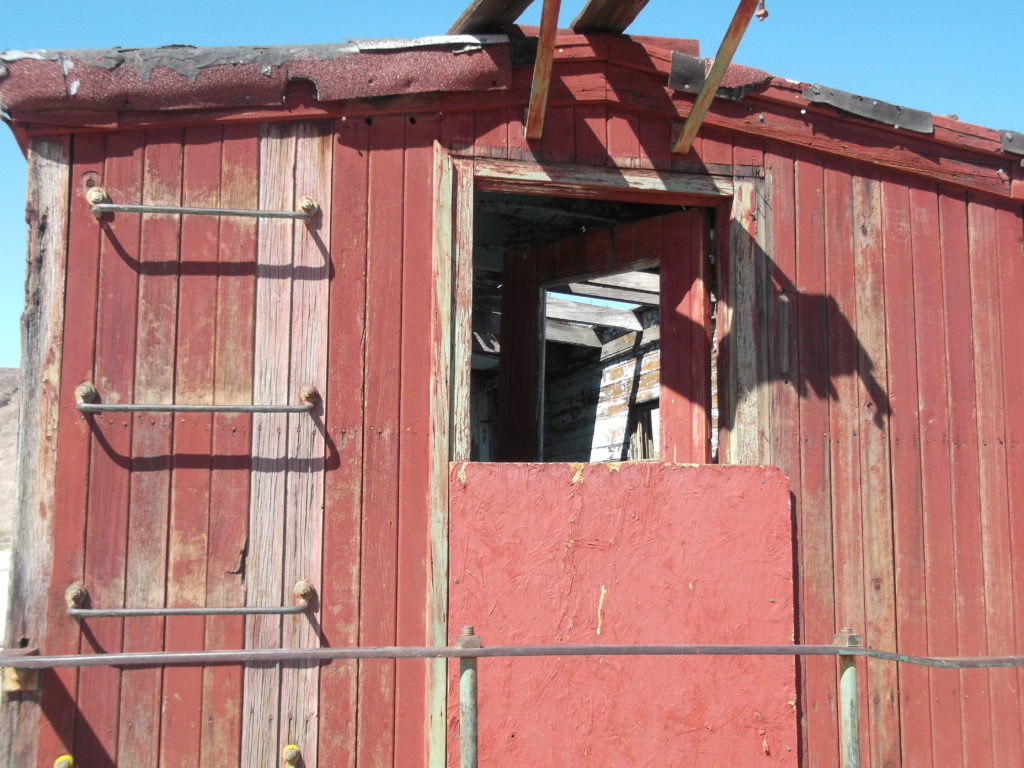
UNION PACIFIC
On arriving at Seattle airport—my first three book events were to take place there—I felt a certain paranoid anxiety as I approached the customs officer. Nowadays visitors to the United States must fill in the ESTA online before their arrival. The ESTA is not as rigorous as it might be, but it does nonetheless leave one with a residual sense of American officialdom’s invasiveness, and it was this which I dreaded. Luckily the interrogation I had feared didn’t materialise; I was finger-printed, which is standard for all visitors to the country and my passage into the baggage claim hall was signalled by a sigh of jet-lagged relief. My wonderful publisher, Lauren Grosskopf, of Pleasure Boat Studio, met me at arrivals and drove me to my hotel in the university district of Seattle; during the ride the cityscape around me assumed a tinge of exhaustion-induced unreality that was both unnerving and alluring.
My impression of Seattle was marred by its British weather: hesitant, moody rain and uniformly overcast skies. I had an outstanding meal at The Brooklyn Seafood Steak and Oyster House on 2nd Avenue with some friends who had very kindly driven down from Spokane to spend some time with me. The restaurant is the kind of place that seems to have stepped out of a 1930’s film noir with its one-person dining booths and air of opulence and leathery ease. Air conditioning and free water, I realised, are ubiquitous in America and the former blows its harsh winds at the slightest sign of heat or humidity and this restaurant was no exception. Friends had prepared me for the priceyness of restaurants; even so, I was shocked at the bill, not to mention the added tax and tipping costs. Sitting there, at the end of an admittedly scrumptious dining experience, I had my first in a series of epiphanies about American capitalism. In the 1950’s America capitalism was accompanied by, and triggered, dreams of opulence, the shiny convenience of giant automobiles and sun-drenched swimming pools; but now that capitalism seems to have gone slightly insane. Capitalism in Seattle, orchestrated by the looming presence of Amazon, Starbucks and Microsoft, has caused rents to sky-rocket and shoved young working professionals onto the street, where they have been forced to make their homes in tents. The city is littered with camping sites: these are not people who are roughing it, or drinking their way to oblivion; or hard-luck cases forced to beg (though there are plenty of these too in America), but qualified employees who simply cannot afford the rent. There was something slightly surreal about the presence of these tents, and while I glimpsed them, it was as if I was momentarily projected into some dystopian, Ballard-ian vision of a future unequal society tilting out of all balance. I have a feeling that these camping sites may soon be appearing in other Western cities. Their presence in America does indeed confirm a surreally unjust level of affluence which is bullyingly evicting and ousting all who do not occupy the upper echelons of wealth. No doubt this is what the finest contemporary exponent and synthesiser of the Seven Deadly Sins—the President of America—and his avaricious lackeys are striving for, as the ubiquitous rule of profit and selfishness sounds its shrill anthem. But it is capitalism gone mad, the disfigured equivalent of a chicken which is mercilessly force-fed in order to spew out more and more eggs before finally collapsing in agony.
My book events went well—the first in the capacious, impressive University Bookstore was especially thrilling, mainly because of my rather narcissistic delight in the sight of twenty beautiful hardback copies of The Fabrications piled up near the stage where my reading was to take place. I was pleased to find some local students in attendance and their spot-on and relevant questions were wonderful. My second event took place at a gallery in another part of town—a half-charming, half-squalid affair named Vermillion on 11th Avenue, complete with a beery smell and a black performance area. Friends of my publisher had kindly turned up in support and I was impressed by the exactitude and insight of the questions posed by people who had already read the book. My final event was in a radically different location—C and P Coffee in West Seattle, which has an air of relaxed, small town charm—the antithesis of the fast-paced efficiency that America is known for and among my audience were voluble, mobile children whose presence was at first grating and finally amusing. My last Seattle event expired, I signed my final book, said goodbye to Lauren, and caught my flight to New York’s Newark airport.
On my arrival at Newark I extravagantly decided to grab a yellow cab. From Newark airport it’s a fast, 30-minute drive into Manhattan and as we raced towards the Holland Tunnel from the southwest my eyes gawked at my first ever glimpse of New York’s skyline. Staring at it one has the sense that within its vertical severity and geometric patterns there lies hidden some great principle of mathematical elucidation if only someone smart enough could unlock it. At that moment fireworks were being set off so I couldn’t have asked for a more iconic or romantic moment. I was inevitably reminded of the last shots of Woody Allen’s opening montage of New York in his movie Manhattan and I quietly instructed my memory to preserve this moment forever on its admittedly aging hard-drive. When I finally made it into my hotel room the city’s cosmic allure seemed almost palpable—a kind of energy, a hum, a massive presence whose frontiers were symbolised, on the one hand, by the skyline’s inscrutable perfection and on the other by the perpetually lit lamps of my hotel room’s cupboard, in whose womb-like embrace sat an assortment of exquisitely presented goodies and spirits, fine mints and a single bar of Fine and Raw Sea Salt chocolate, so stylishly packaged that it would have been sacrilege to open it. New York after Seattle was like whisky after ginger ale, oysters after tuna. I went to bed feeling happy and excited.
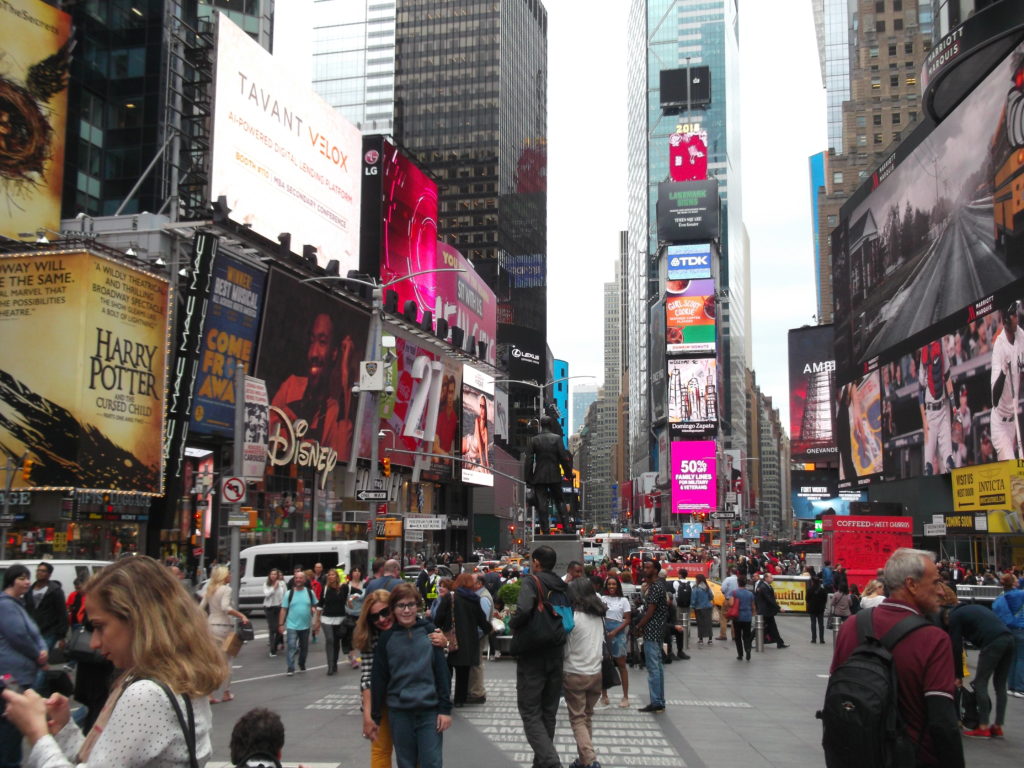
TIMES SQUARE
Wandering around New York I realised that I had already experienced the city in various manifestations of artistic simulation. Indeed America itself is a land that has been photographed, filmed, shot, revealed, promoted to excess. New York is all about form, packaging, style, glamour. Americans do glamour very, very well and New York still appears to relish its starring role as high priest of style and emblematic razzle dazzle. Whether it’s Times Square’s billboard upgrades of neon and light, or the ethereal yet concrete beauty of Grand Central Station or the super dustless chic of Fifth Avenue, New York is a city of flashes of familiar, reproduced, imitated beauty. After the shambolic charm of Italy’s logic-less streets and alleys, New York’s numeric clarity was clarifying. I, who am the most geographically illiterate person on the planet, even I could negotiate my way around the city and I was comforted by the linearity of the Big Apple. Charming sights were everywhere; two men clutching a poodle as they weaved through the traffic of the city on a Segway; street musicians letting it all hang out; the elegance and space of MOMA; and, most unforgettably of all, my up-close and personal view of the Statue of Liberty on Liberty Island. The most iconic image of the modern world is, in the flesh, strangely unreal: it is almost as if its photographed reality has eclipsed its actual one, and yet the precision of its lines and arcs, and its giant, cosmic face form an epicentre of elegance mysteriously in harmony with Manhattan’s far-off matrix of verticals. In that synthesis one sees the whole trajectory of modernity laid out. Inevitably the city’s grandeur is undermined by flashes on the awfulness of the attacks on the Twin Towers, itself a kind of horrifying real-life enactment of the premises of Hollywood disaster movies. The New Yorkers I spoke to told me that the city never really recovered its pre-9/11 confidence, that afterwards things were never quite the same. And I must say I felt too that New York was like a truncated version of its untouchable, unflappable former self. Yes, the city still buzzes, yes, it is still New York, but people are wary, wrapped up in themselves or head sets and iPods, and the mobile phone itself has effectively killed spontaneity and real, full engagement with another human being in the three-dimensionality of the audio-visual present tense. In addition, the city’s sheer expensiveness borders on the demented: I had breakfast in a very modest café one morning and ended up paying $19 for a coffee, roll and slice of cake. The US dollar has been rendered effectively valueless. These signs might seem to indicate that America is headed for another economic crash or even hyperinflation. The system as it currently stands doesn’t seem to be sustainable. The enormity of the American debt and the sheer price of living are sounding an ominous warning in many people’s minds.
My two New York readings couldn’t have been more different: my first, in Greenwich Village’s Cornelia Street Café, didn’t go so auspiciously. I had been teamed up with two other Pleasure Boat Studio writers: Siegfried Kha, a charming cardiologist turned memoirist, and the brilliant, effervescent and incisive Robert Karmon, a famed playwright and novelist whose book about the Jewish holocaust Isaac is an extraordinarily powerful and raw recreation of a real-life hero’s determination to survive unbelievable hardship and trauma. I was honoured and pleased to be able to spend time with these two elder gentlemen, but their books’ subject matter—the Jewish holocaust and its aftermath—couldn’t have been more different to my own book’s satirical focus on the contemporary media. The Cornelia Street Café’s basement stage is probably the most wonderful single venue I have ever performed in, but, sadly, that night only half a dozen people got to sample its nuanced, atmospheric décor. By contrast my next reading in Soho’s Pomegranate Gallery was wonderfully light: some thirty people were there, the mood was ebullient, the crowd receptive and agile, the questions interesting and perceptive. I felt that I shone and the good vibes were augmented by the presence of two dear NYC writer friends who had shown up to cheer me on. Later we repaired to a nearby watering hole and my mood was euphoric to say the least. I had presented my book, a book I had labored over for years, in one of the most attractive of small galleries in the epicentre of New York and it had gone down well. What more could I really ask of life?
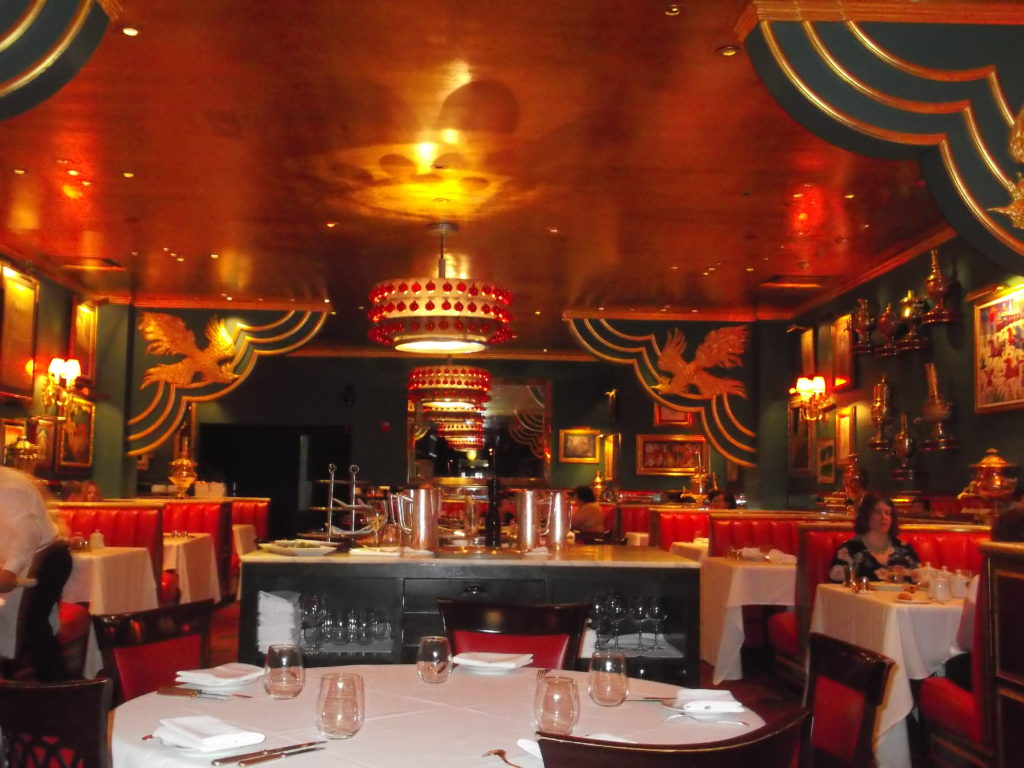
THE RUSSIAN TEA ROOM
My next stop was Las Vegas. I arrived late in the evening and was troubled to find that two out of the three taxi drivers I approached hadn’t heard of my destination—a friend’s place in North Vegas, far away from the Strip, which is Vegas’s hedonistic molten core. I subsequently discovered that taxi drivers don’t like to take tourists to far-off destinations and prefer to deal with clients who are staying nearby. The second driver I approached was certainly clueless and probably drunk, but luckily my third candidate seemed to know what he was doing and where he was going and I was treated to the sight of the fabulously gaudy lights and high rise hotels of the strip as we sped towards suburbia. Night is of course the best time to see the Strip; not that there is really any time in Vegas; it is fitting that an artificial construct at the end of the Mojave Desert should itself be artificially free of time in that everything within central Vegas stays open all the time and so the city is a haven for insomniacs and night owls and they can find within it 3am dinners and 5am bowling alleys without much fuss. If you are a nocturnal animal, one resident told me, you can flourish there and if you are prone to cross-dressing, or have exotic or strange tastes in other departments, Las Vegas will tolerate your id’s imperatives with a grace that you will not find elsewhere in America. The fact that Vegas is such an obviously sealed bubble is, I must admit, a source of fascination and repulsion in equal measure. As my friend and I roamed the streets and took in the sight of the recreated and kitsch-ified Eiffel Tower and Trevi Fountain I couldn’t help thinking that the city would make a fabulous setting for a short story or novel in that its essential unreality is by nature close to the stylised world of fiction. No other city is so sharply defined, so obviously a caricature of itself and so blatantly honest about its vulgarity and bid to turn consumerism into a frenzy. Ladies of the night roam the bars looking for clients and their profession is easy to ascertain as they ply their trade without friends or drinking partners. The city’s pernicious side is probably rarely noticed by those millions who flock to it, drawn by the absurd promise of hitting the jackpot or getting married or ecstatic levels of pleasure; but the harsh, unglamourous reality is that some of the most addicted of gamblers even have to wear adult diapers as they simply cannot break their gambling long enough for a visit to the bathroom, as an ex-waitress informed me. It’s that bad.
But I was not in Vegas to sample its purgatorial temptations. Actually, I was there to drive across the Mojave Desert as a novel I am working on is set there and I figured I might as well combine my book tour with a road trip/fact-finding mission. To this end my friend Sean and I had hired a convertible Chevrolet whose speedy delights I sampled as we drove out of the city and joined Highway 95, bound for Carson City in Nevada. It was an epic ride, and the sun, wind, and music we had roaring out of the stereo, plus the fact of a roofless immersion in the sublime nullity of the desert, proved as intoxicating as any drug, legal or otherwise, I have sampled. This vast canvas of nothingness and the hypnotic sight of dust devils (miniature tornadoes spinning mysteriously in the distance) combined to take me into some other dimension. In the far-off distance the heat causes mirages to slither into being, as shadows appear to rise and fall from the road in slender, heat-encased formations. We made one or two stops at greasy spoons and so-called Alien Centres—mini-markets that sell refreshments, and alien posters, T-shirts and alien dolls. Next to one of them we found a large sign announcing two brothels, which are legal in Nevada, and carry no sense of stigma, a fact confirmed by the cashier’s cheerful question about whether or not we’d visited them yet. The desert is indeed another universe and if you have a breakdown here you’d better pray that someone takes pity on you and stops to help because mobile phone signals are spasmodic and there is literally nothing in between the occasional small towns and gas stations along the route. Here and there you come across lakes in whose surface the sky and clouds are brilliantly reflected and with a vividness and clarity that borders on the supernatural, so much so that it seems as if the lakes contain the clouds and sky and do not merely reflect them. We stopped briefly at Goldfield, a ghost town, and came across an abandoned and falling into ruin train carriage that was straight out of the Wild West: an eerie moment, and the sight of gold mines and shacks gave me a sense of how primitive and dangerous life must have once been out there. It is a landscape that modernity has barely touched and you’d be forgiven for thinking that for the most part you had in fact taken a trip on a time machine and been cast back into a landscape of pre-historic crudeness. When we finally arrived in Carson City our hotel appeared at that moment like a holy shrine and my clean and comfortable bed like an emblem of civilised paradise.
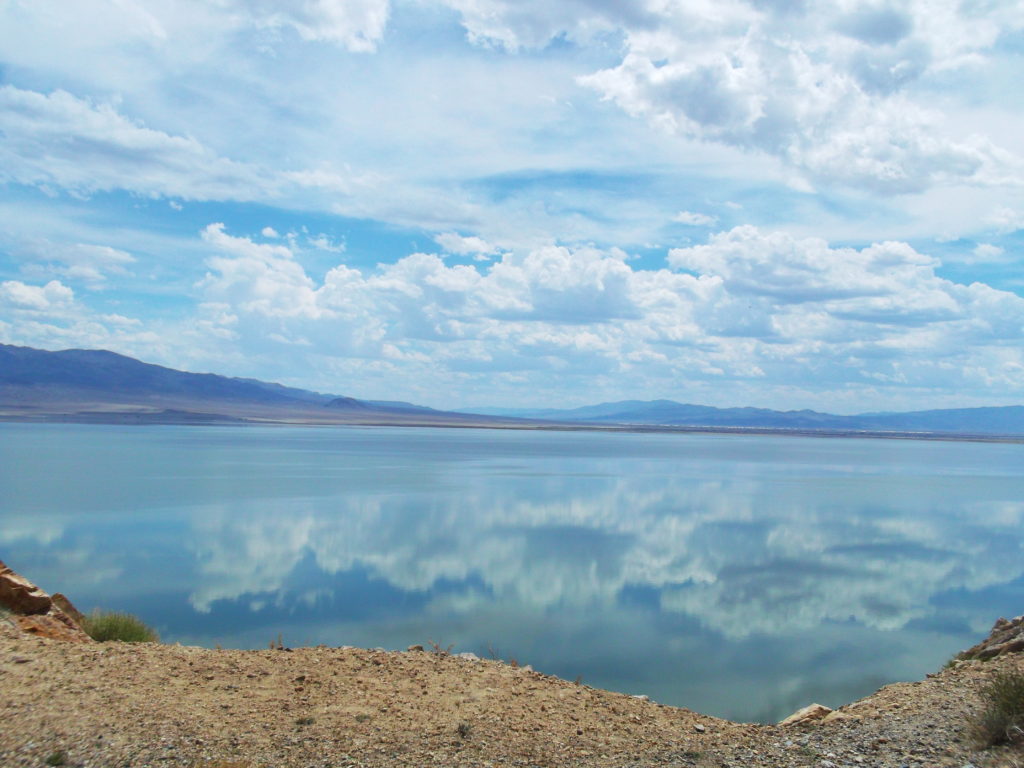
DESERT LAKE IN THE MOJAVE
My final stop was San Francisco and my last book event was to take place in Oakland, which is a 40-minute drive away. Upon arrival in the Bay Area I realised that I had started to succumb to Americana fatigue and that I was no longer really processing all the information or dealing with all the time-zone shifts. The extremely slanted and steep side streets of San Francisco appear to have stepped out of a surrealist painting and this, together with the fact that the city exists along a fault line, lend the place a curiously indeterminate, melancholic, and dreamy feel. Free coffee is doled out in the diners and coffee shops, people are friendly and liberal, the famed City Lights bookstore even stocked my novel. And yet I found San Francisco’s wide boulevards, its gigantic Golden Gate Bridge, its vast oceanscape and colourful assortment of trends and vegan food and great cuisine all tinged with something namelessly sad. Maybe I was just fatigued or maybe I had expected greater things from my book tour, greater numbers, better sales, more momentous literary meetings. Or maybe California has been so well promoted and sold, the Summer of Love so fondly evoked and recalled that the reality was just a little bit flat and bittersweet. Yes, I had a great Mai Tai cocktail in a great beach bar where I watched startlingly elegant hang-gliders strutting their stuff; yes, my reading in Oakland’s Octopus Literary Salon was well attended and had allowed me to dialogue with my long-standing pal Lee Foust, ace raconteur and writer; yes, I got to spend some time in the Napa Valley and sip fine wine and picnic with new friends in the embrace of nature, and yes, I went to a great bar called Specs in downtown San Fran which, on the night I visited it, seemed to have among its clientele a cross section of all of America: hillbillies, liberal looking hipsters and a couple of residual beatniks, Bukowksi-esque looking older men liaising with, and/or fondling the ass of, a scantily clad statuesque girl with visible bra and tattoos, yes, I did and saw and enjoyed all of that. But maybe my gnawing sense of unease was best expressed by the sight of seventeen television screens that I counted in the burger bar I went to after my reading. The place was already loud and conversation already had the odds stacked against it. But seventeen television screens? Why in God’s name would anyone need to install so many televisions in a place that was primarily designed for the consumption of food? That place seemed to be saying: don’t talk, eat; and when you have finished eating, watch. And then pay the bill, pay the added tax, and leave the tip. Don’t think too much and above all don’t say too much. I wonder sometimes what things will be like in another ten years… Maybe we will see crowds of people conversing with three dimensional holograms of friends from far-off places in restaurants and bars. But whatever happens, whatever innovations take place in technology, you can bet your bottom dollar that they will happen first in the embrace of Silicon Valley and the West Coast of America. America’s precocious, super accelerated route to technological transformation will proceed apace, dragging the rest of the world into grotesque new kinds of progress, while at the same time it will continue to bully and browbeat and rob from other cultures and the rest of the world and its less well endowed, less well-off neighbours.
My trip to America was intense, rich, breathless but it also left me with a vivid sense of a land that is in both economic and spiritual crisis, a country whose brilliance and creativity seem to go hand in hand with its ruthlessness and relegation of the human and humane to subordinate strata of society. At a moment in history when so much is at stake, politically, culturally, environmentally, I am hoping that conversation will win out over television, that we’ll find a way of ensuring our souls are not vaporized by technology, and that the gleaming freedoms that America once stood for might be snatched back from the claws of present day captivity. It would be a victory for the human spirit, don’t you agree?
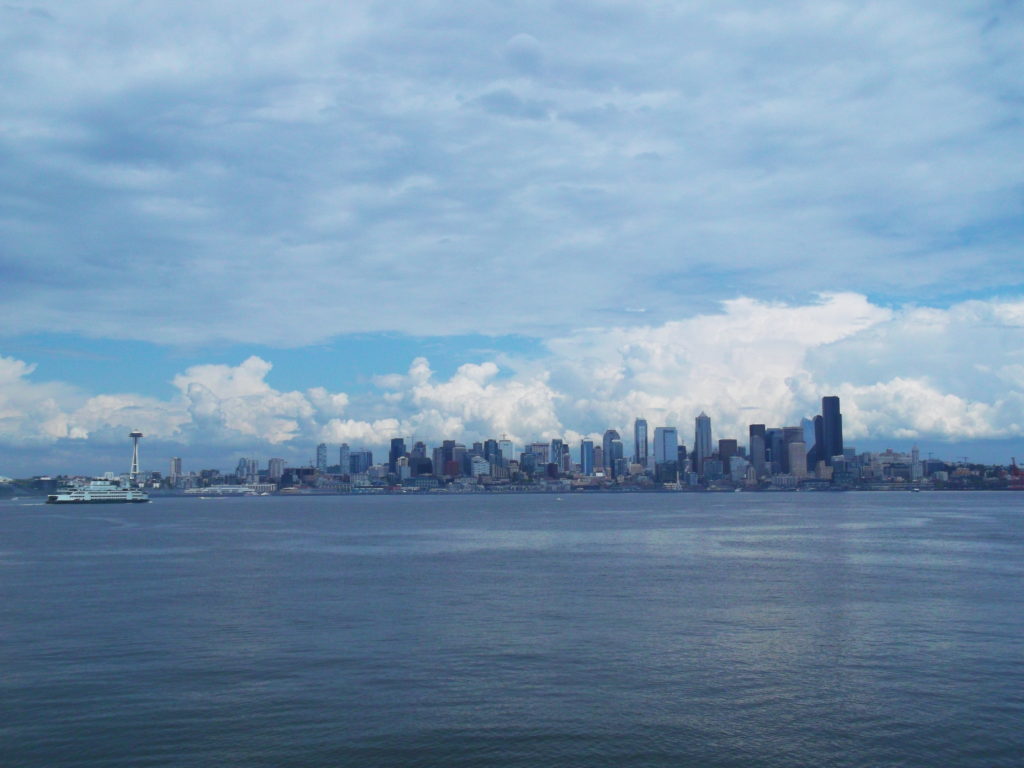
SEATTLE
?
What if what seems like last stop were really just the first stop?
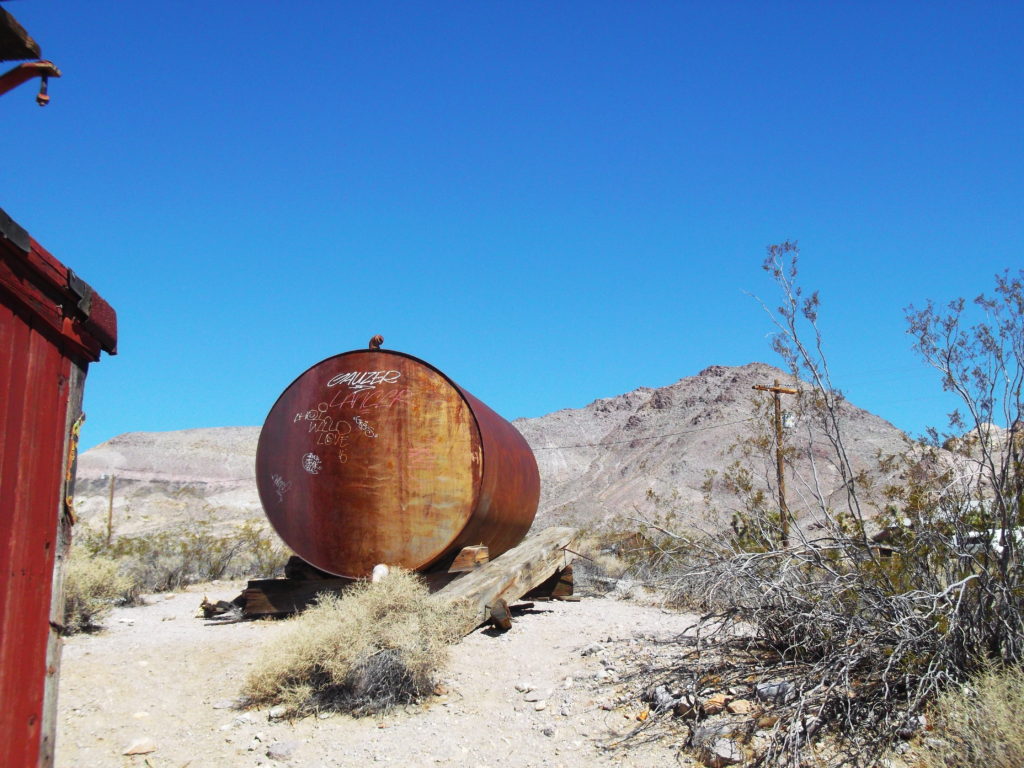
ON THE ROAD
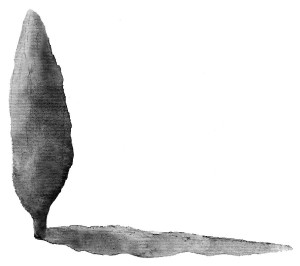
ISSUE 22 • Spring 2019 will be published in September.
Visit www.thesighpress.com for details.
© 2019 THE SIGH PRESS
None of the work published by The Sigh Press may be copied
for purposes other than reviews without the author and artist’s written permission.